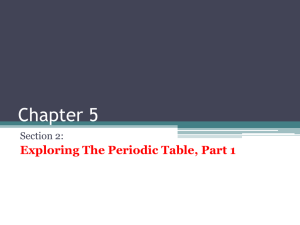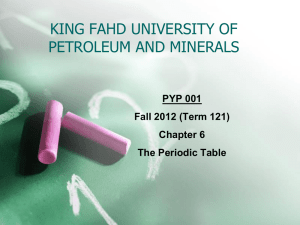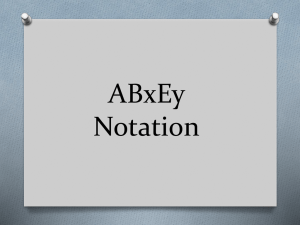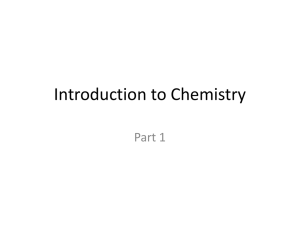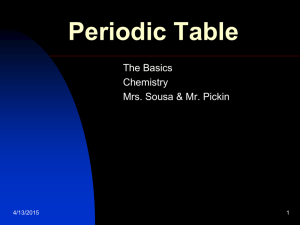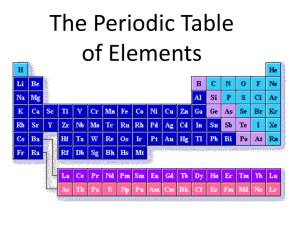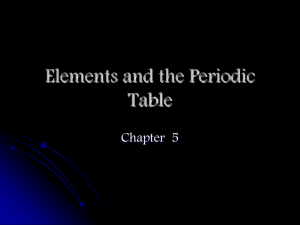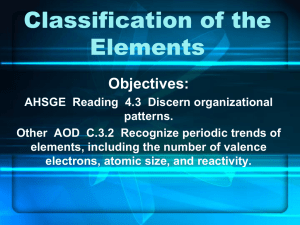Unit 3 The Periodic Table
advertisement
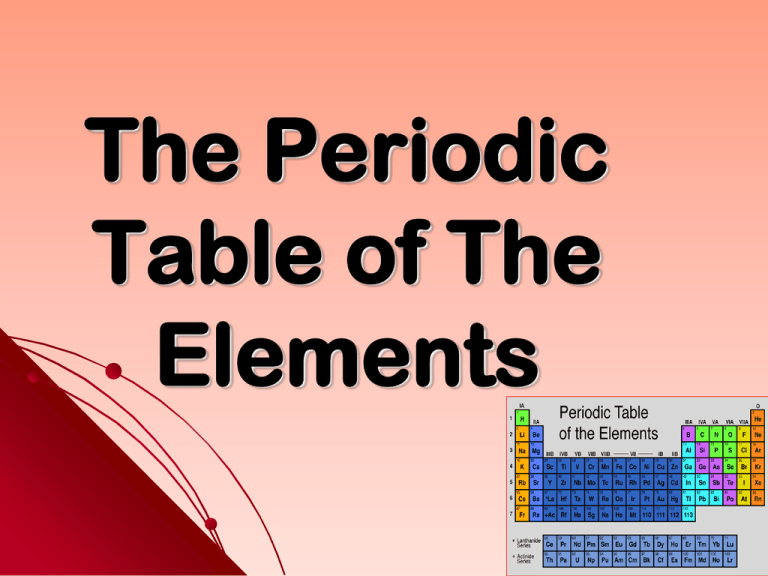
The Periodic Table of The Elements The Periodic Table Arrangement of the known elements based on atomic number and chemical and physical properties. Divided into three basic categories: Metals Nonmetals Metalloids Basic Organization The periodic table is organized by: Atomic structure Atomic number Chemical and Physical Properties Uses of The Periodic Table The periodic table is useful in predicting: chemical behavior of the elements trends properties of the elements Atomic Structure Review Atoms are made of protons, electrons, and neutrons. Elements are atoms of only one type. Elements are identified by the atomic number (# of protons in nucleus). Energy Levels Review Electrons are arranged in a region around the nucleus called an electron cloud. Energy levels are located within the cloud. At least 1 energy level and as many as 7 energy levels exist in atoms. Energy Levels Review Electrons in levels farther away from the nucleus have more energy. Inner levels will fill first before outer levels. Energy Levels & Valence Electrons Energy levels hold a specific amount of electrons: 1st level = up to 2 2nd level = up to 8 3rd level = up to 8 (first 18 elements only) Energy Levels & Valence Electrons The electrons in the outermost level are called valence electrons. Determine reactivity - how elements will react with others to form compounds Outermost level does not usually fill completely with electrons Due Today Two column notes save as a PDF Video watched with comment Due Tomorrow Interpreting the Periodic Table Warm Up Log Current Event Elements & Reactivity Reactivity is a chemical property that determines how elements will react with others to form compounds. Elements & Reactivity What makes an element reactive? ● ● ● Number of valence electrons each atom has When outer levels are full, atoms are stable. When they are not full, they react: ● gain, lose, or share 1 or 2 electrons. Elements & Reactivity The most reactive metals are the elements in Groups 1 and 2. Video http://www.youtube. com/watch?v=xxi6k Ubvo94 Elements in Group 1 need seven more electrons to fill their outer level. Elements in Group 2 need six more electrons to fill their outer level. These groups are known as the “givers” because they easily give up their valence electrons to make a compound. Elements & Reactivity The most reactive nonmetals are the elements in Groups 16 and 17. Fluorite Elements in Group 16 only need two more electrons to fill their outer level. Elements in Group 17 only need one more electron to fill their outer level. These groups are known as the “takers” because they easily receive valence electrons to make a compound. Using the Table to Identify Valence Electrons Elements are grouped into vertical columns because they have similar properties. These are called groups or families. Groups are numbered 1-18. Using the Table to Identify Valence Electrons Group numbers can help you determine the number of valence electrons: Group 1 has 1 valence electron. Group 2 has 2 valence electrons. Groups 3–12 are transition metals and have 1 or 2 valence electrons. Using the Table to Identify Valence Electrons cont. Groups 13–18 have 10 fewer than the group number. For example: Group 13 has 3 valence electrons. Group 15 has 5 valence electrons. Group 18 has 8 valence electrons. Switch to Mimio Group 1: Alkali Metals Contains: Metals Valence Electrons: 1 Reactivity: Very Reactive Properties: solids soft react violently with water shiny low density Sodium Group 2: Alkaline-Earth Metals Contains: Metals Valence Electrons: 2 Reactivity: very reactive, but less reactive than alkali metals (Group 1) Properties: Solids Silver colored More dense than alkali metals Magnesium Groups 3-12 Transition Metals Contain: Metals Valence electrons: 1 or 2 Reactivity: less reactive than alkali and alkaline-earth metals Properties: Higher density Good conductors of heat and electricity Copper Groups 3-12 Transition Metals Below Main Table Contain: The Lanthanide and Actinide Series These two rows are pulled out of sequence and placed below the main table to keep the table from being too wide. Lanthanides are #’s 58–71. Actinides are #’s 90–103. Plutonium Groups 3-12 Rare Earth Elements ~ Lanthanides Lanthanides follow the transition metal # 57 Lanthanum in Period 6. Valence electrons: 3 Reactivity: Very reactive Properties: ● ● Cerium ● High luster, but tarnish easily High conductivity for electricity Very small differences between them Groups 3-12 Rare Earth Elements ~ Actinides Actinides follow the transition metal # 89 Actinium in Period 7 Valence electrons: 3 (but up to 6) Reactivity: unstable All are radioactive Most made in laboratories Uranium Metalloids A zig-zag line that separates metals from metalloids Elements from Groups 13– 17 contain some metalloids. These elements have characteristics of metals and nonmetals. Group 13: Boron Group Group 13: Boron Group Contains: 1 metalloid and 4 metals Valence Electrons: 3 Reactivity: Reactive Other shared properties: Boron Solid at room temperature Group 14: Carbon Group Contains: 1 non-metal, 2 metalloids, and 3 metals Valence Electrons: 4 Reactivity: Varies Other shared properties: Carbon Solid at room temperature Group 15: Nitrogen Group Contains: 2 non-metals, 2 metalloids, and 1 metal Valence electrons: 5 Reactivity: Varies Other shared properties: Nitrogen All but N are solid at room temperature Group 16: Oxygen Group Contains: 3 non-metals, 1 metalloid, and 2 metals Valence Electrons: 6 Reactivity: Reactive Other shared properties: Oxygen All but O are solid at room temperature. Groups 17 : Halogens Contain: Nonmetals Valence Electrons: 7 Reactivity: Very reactive Other shared properties ● ● ● Chlorine Gas Poor conductors of electric current React violently with alkali metals to form salts Never found uncombined in nature Group 18 Noble Gases Contains: Nonmetals Valence Electrons: 8 (2 for He) Reactivity: Unreactive (least reactive group) Other shared properties: Colorless, odorless gases at room temperature Outermost energy level full All found in atmosphere Neon Hydrogen Stands Apart Hydrogen in it’s Plasma state H is set apart because its properties do not match any single group. Valence electrons: 1 Reactivity: very, but loses the 1 electron easily Properties: Similar to those of nonmetals rather than metals Warm Up WAIT TO TURN THIS IN!!!!!!!!!!!!!!!! Due Today Due Today Two column notes save as a PDF Warm Up Log saved as a PDF Current Event Video watched with comment Interpreting the Periodic Table Periods Periods run horizontally across the Periodic Table Periods are numbered 1–7 All the elements in a period will have the same number of energy levels, which contain electrons. Examples: Period 1 atoms have 1 energy level. Period 2 atoms have 2 energy levels. Period 5 atoms have 5 energy levels. Mimio Periods Continued Moving from left to right across a period, each element has one more electron in the outer shell of its atom than the element before it. This leads to a fairly regular pattern of change in the chemical behavior of the elements across a period. Mimio Quiz Quiz Trade Brief History of the Periodic Table Brief history of the periodic Table When Who What Ancient Greece In Ancient Greece, people believed that there were only four elements….. Earth Fire Water Air What were scientist looking for when they found the first element Alchemists They were looking for the philosopher’s stone, which reputedly could change base metals into gold Hennig Brand 1649 Made the first scientific discovery of an element Phosphorus He isolated from urine, a white, waxy material and named it phosphorus (“light bearer”), because it glowed in the dark. A.E. Beguyer de Chancourtois 1817 Listed elements on a cylinder in order of increasing atomic mass Johann Dobereiner 1862 Proposed there were triads of three elements in nature with the mass of the middle element being the average of the other two Law of Triads Found that the properties of bromine seem halfway between those of chlorine and iodine. He showed that in each triad the mean of the lightest and heaviest atomic weights approximated the atomic weight of the middle element. In other words…. 4………6.......8 John Newlands 1863 Classified the 56 known elements into a table with 11 groups based on properties. He proposed that any element will behave similar to the 8th element following it. Law of Octaves Lothar Meyer 1864, German Developed a shortened version of the table only showing half of the known elements. Elements were listed in order of atomic mass and differences in behavior were due to mass. He published a longer version in 1869 but it wasn’t published until 1870 Dmitri Ivanovich Mendeleev 1869, Russian Rearranged elements in order of their properties. He showed a vertical, horizontal and diagonal relationship between the 63 known elements Predicted three yetto-be-discovered elements including eke-silicon and ekeboron Lord Rayleigh 1895 Discovered argon and found it didn’t fit in the current groups. In 1898 he proposed a new group to be called zero group because argon was unreactive (inert) Ernest Rutherford 1911 Studied nuclei which led to the concept of nuclear charge Positive Charge and Protons Henry Mosely 1913 Published results of x-ray wavelengths of elements which proved the elements are in order of atomic number. He used increasing atomic numbers and not atomic masses Glenn Seaborg 1940 Discovered plutonium and all elements from 94-102. He moved the Lanthanides and Actinides below the table. Discovered 10 different elements to include seaborgium, which was named after him credited with important contributions to the chemistry of plutonium, part of the Manhattan Project where he helped develop fuel for the second atomic bomb pioneer in nuclear medicine, most notably iodine-131, which is used in the treatment of thyroid disease. Quiz Quiz Trade Various Periodic Table Go to this website and look at the different periodic tables for the rest of class http://www.metasynthesis.com/webbook/35_pt/pt_data base.php?Button=pre1900+Formulations Warm Up Brief History of the Periodic Table Did the grouping change once you started posting them on the board? Was it easier to group the atoms once you understood the property needed to group them? Do you think that the periodic table will remain in the same form as it is now? Patterns Next blank page of you spiral title Patterns Number 1-5 and leave 3 lines between each number Periodic Trends What does periodic mean? What does trend mean? Are the tendencies of certain characteristics of the atoms to increase or decrease along a row or column of the periodic table of elements What are some of the patterns found in the periodic table? A pattern of gradual change or movement What might be a good definition for periodic trends? Recurring at regular intervals Average atomic mass increases right to left and top to bottom How does the arrangement of the periodic table allow for the prediction of undiscovered elements and their properties? patterns Atomic Number INCREASES Metalic Properties INCREASES Valence Electrons Down a Group Remain the Same Valence Electrons Across a Period INCREASE Warm Up Agree or Disagree and Why The following elements all belong to the same period: Ne, Ar, Kr, and Xe. The following elements all belong to the same group/family: H, Li, Na, and K. Agree because they all have the same number of valence electrons. All elements in group 13 have 3 valence electrons. Disagree because they all have different numbers of energy levels. Agree because all elements in group 13 have ten less than stated, and all elements in a group have the same number of valence electrons. The chemical reactivity of an element is determined by its protons. Disagree because the reactivity is determined by the number of valence electrons Warm Up Study your spiral Write “Test” on your warm up log After the Test Turn in your spiral on lab table 2 STAY QUEIT You may read, work on homework, or log on to study island If we have time I will check your grades after the test
